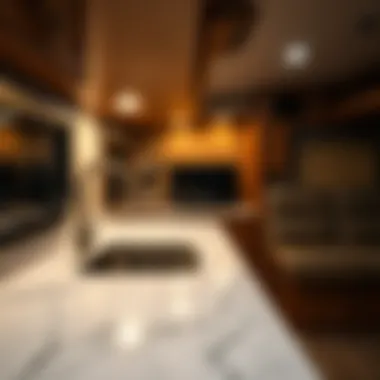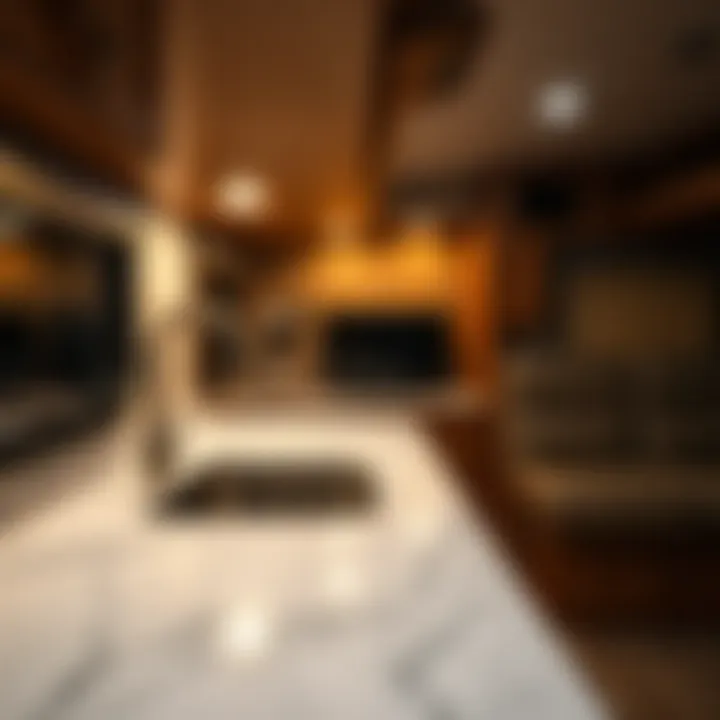Lightweight RV Countertops: A Comprehensive Guide


Intro
RVs are more than just vehicles; they represent a lifestyle choice for many. As travelers hit the open road, the desire for comfort and usability in their mobile living spaces becomes paramount. Among various features that define an RV's comfort, the countertops hold a significant place. When choosing surfaces that need to withstand frequent use, lightweight materials have emerged as a game changer in the RV world.
The market for lightweight RV countertops is evolving rapidly. As manufacturers continue to innovate, understanding the distinct advantages of these materials becomes essential. This guide aims not only to explore the myriad options available but also to provide perspectives on material performance, aesthetics, and practical maintenance. By the end, RV owners and enthusiasts should feel equipped to make informed decisions tailored to their unique needs.
Market Research Overview
Industry Trends and Insights
The shift in consumer preferences towards more lightweight and durable materials marks a notable trend in the RV countertop market. As RV enthusiasts become more eco-conscious, materials such as recycled surfaces are gaining traction. These innovations provide both functionality and sustainability which aligns with a growing number of buyers who want to reduce their environmental footprint while enjoying their adventures.
Moreover, the trend of minimalist aesthetics is influencing design choices too. Clean lines and simple colors now dominate the market as consumers lean toward a more streamlined look that complements their home on wheels. Some manufacturers are investing in technology to provide surfaces that are not only lightweight but also easy to clean and maintain.
"Lightweight materials have changed the landscape of RV design—function meets style without the added weight!" - RV Enthusiast Forum
Consumer Demographics
The demographics of RV owners indicate a wide range of age groups and lifestyles, but some specific trends can be recognized. Younger buyers, often millennials, are gravitating towards RVs for adventures and experience over material possessions. Subsequently, they lean towards lightweight solutions that optimize space and enhance aesthetics.
In contrast, many seasoned RV travelers, often in the older age bracket, seek durability and low maintenance. They prefer countertops that withstand the rigors of travel yet still maintain a refined appearance. This demographic oscillates between wanting elegance and practicality, leading manufacturers to develop diverse product lines catering to both preferences.
Reviews and Ratings
Detailed Product Breakdown
When exploring lightweight countertop options, several materials stand out:
- Corian: Known for its durability and seamless appearance, this solid surface material is a favorite among many RV owners. Corian is non-porous, making it resistant to stains and easy to clean.
- Laminate: A cost-effective choice, laminate comes in various designs and colors. It is lightweight, but durability can vary, making it essential to select higher-quality options.
- Quartz: Engineered quartz offers a balance of style and resilience. While slightly heavier, recent advancements in manufacturing have made lighter variants available.
- Plywood with Resin Coating: An innovative approach, this combines traditional materials with modern technology. It is lightweight, and when properly treated, can be very durable for an RV environment.
Expert Review Summaries
Feedback from experts indicates a clear preference for materials that not only fit lightweight specifications but also provide a high degree of functionality. Reviews highlight the importance of choosing countertops that meld visual appeal with practical benefits, directly impacting the RV experience. Features such as resistance to scratches and ease of installation are often discussed among top-rated choices.
In the online world, platforms like Reddit and specialized RV forums act as a treasure trove for unbiased user experiences. Customers continuously share their insights on which materials work best under specific conditions, fostering a sense of community and support among RV enthusiasts.
As the sector continues to grow, staying informed about the latest developments can make all the difference in creating the perfect mobile living space while ensuring that travelers enjoy every moment spent on the road.
Understanding Lightweight RV Countertops
Lightweight RV countertops are not just a passing trend in the world of recreational vehicles. They play a pivotal role in enhancing the functionality and aesthetic appeal of these mobile living spaces. As RV enthusiasts often seek ways to optimize every inch of their homes on wheels, understanding the essence and benefits of lightweight countertops becomes paramount.
Definition and Importance
At its core, a lightweight RV countertop refers to surfaces specifically designed to be both durable and light, accommodating the unique challenges of vehicular movement. Unlike traditional countertops that may weigh down an RV, these materials allow for increased mobile flexibility without compromising on quality.
The importance of lightweight countertops goes beyond just weight reduction. An RV equipped with a carefully chosen countertop can foster a more pleasant camping experience. For instance, a heavier countertop could affect the RV's fuel efficiency. By selecting lightweight options, RV owners directly contribute to better fuel economy, less strain on the vehicle, and ultimately, a more enjoyable travel experience. Not to mention, these countertops often come in various finishes, allowing owners to personalize their space.
Key Characteristics
Lightweight countertops boast several defining characteristics, making them exceptionally suited for RV applications. Here are a few critical points to consider:
- Weight: The primary feature is their reduced weight, which helps in maintaining overall vehicle balance and enhances fuel efficiency.
- Durability: Although they are lightweight, many of these materials do not skimp on strength. They are often designed with resilience to withstand the wear and tear associated with travel.
- Moisture Resistance: Given the often humid conditions in which RVs operate, many lightweight countertops are designed to resist moisture damage. This characteristic is crucial in preventing mold and ensuring longevity.
- Easy Installation: These countertops typically come in manageable sizes for easy installation and can fit into various design layouts without extensive modifications.
In summary, understanding lightweight RV countertops isn’t just about knowing what they are; it’s about appreciating their role in the overall RV experience. By knowing their importance and key traits, RV owners can make informed choices, leading to smarter renovations and ultimately enhancing the joy of the open road.
"Choosing the right materials can transform your RV experience. It’s not merely about aesthetics but also functionality and overall enjoyment on your journeys."
Materials Used in Lightweight RV Countertops
When it comes to RV countertops, the material choice is pivotal. Lightweight materials not only help in reducing the overall weight of the vehicle but also add to the aesthetic appeal and functionality of the kitchen or living area. It’s about striking a balance between durability, appearance, and ease of maintenance. In this section, we will explore various lightweight materials used in RV countertops, providing insights that can aid in making informed decisions.
Popular Lightweight Materials
Laminate
Laminate countertops are made from layers of resin and paper pressed together, providing a smooth finish that’s easy on the eyes. One of the standout characteristics of laminate is its affordability. This makes it an attractive option for those seeking to balance budget with style. A unique feature of laminate is its versatile design capability; it comes in a variety of colors and patterns that can mimic the look of more expensive materials like granite or wood.
However, it isn’t without its drawbacks. While laminate is quite resistant to stains and scratches, it can be susceptible to heat damage. This means using a hot pot directly on it could lead to unsightly peeling or bubbling. Even so, for many RV enthusiasts, the benefits outweigh these risks, particularly in terms of cost-effectiveness and style.
Solid Surface
Solid surface materials, such as Corian, offer a seamless and sophisticated look, perfect for offering a touch of elegance to an RV's interior. One key characteristic of solid surfaces is their durability; they resist stains, scratches, and even some forms of impact damage, making them highly functional for RV life.
A unique aspect of solid surface materials is their ability to be repaired easily. Minor scratches can be buffed away, and chips can be filled, extending the life of the countertop significantly. However, they do tend to be on the pricier side compared to laminate options. This can be a consideration if budget constraints are in play, but their long-term durability justifies the investment for many consumers.


Quartz
Quartz countertops consist of 90% natural quartz crystals and resins, yielding a sturdy material with a polished finish. The unique characteristic of quartz is its non-porous nature, which means it doesn't harbor bacteria or stains, making it an excellent choice for health-conscious users.
In terms of maintenance, quartz is quite forgiving. Wiping it down with soapy water typically suffices to keep it clean. On the downside, quartz can be heavy, so RV owners must consider the structural implications. The balance of beauty and sturdiness makes it a sought-after option, especially for those who don’t mind the weight for a more luxurious aesthetic.
Wood Alternatives
For those who crave the warmth of wooden countertops but are wary of the associated weight and care, wood alternatives provide a compelling solution. These materials often utilize composite technology to mimic the appearance of natural wood while offering lighter weight and resilience.
A key feature is the resistance to moisture, which is crucial in the often humid environments that RVs can encounter. Although they can be more expensive than laminate options, their life-like aesthetic combined with durability often garners high marks from consumers. The trade-off comes in the form of potentially limited options compared to real wood, but the practical advantages generally make them worthwhile.
Comparative Analysis of Materials
Each material comes with its unique benefits and drawbacks, making them suitable for different users. Let's break it down:
- Laminate is economical and diverse in design but may not hold up against extreme heat.
- Solid Surface offers aesthetics and easy repairs, but can stretch the budget.
- Quartz provides durability and cleanliness; however, its weight might pose challenges in an RV setting.
- Wood Alternatives give the warmth of wood with better moisture resistance but can be pricey.
Benefits of Lightweight RV Countertops
Lightweight RV countertops offer a multitude of advantages that go beyond mere aesthetics. They bring essential benefits to the table that can significantly affect the overall RV experience. This section will dive into three core benefits: space optimization, improved fuel efficiency, and easier maintenance. Each of these elements plays a critical role in making your mobile living experience more enjoyable and practical.
Space Optimization
When it comes to RV living, making the most of every inch counts. Lightweight countertops contribute to space optimization by their very nature. Traditional heavy materials can lead to bulky designs that not only absorb space but also limit movement and functionality.
For instance, a family planning a long weekend trip in a 28-foot RV might find that the typical heavy granite countertop makes their galley feel more cramped. In contrast, opting for a lightweight material like laminate or solid surface can open up room for storage solutions or additional cabinetry, streamlining the organization of your kitchen space.
Here are a few ways in which lightweight countertops enhance space utilization:
- Reduced Weight: Less weight means less structural stress on your RV, allowing for more innovative design options.
- Flexible Designs: Lightweight materials are often easier to shape and install, offering a broader range of designs, including curvy edges and integrated sinks.
- Increased Functionality: With a spacious feel, RVers can move more easily between the dining area and kitchen, making meal prep more efficient.
"Maximizing space in an RV is akin to solving a puzzle – every piece matters!"
Improved Fuel Efficiency
Fuel efficiency might not be the first thought when considering RV countertops, but it’s a vital element for many RV owners, especially those embarking on longer road trips. Lightweight materials provide a key advantage in this arena; they reduce the overall weight of your vehicle. A lighter RV requires less energy to propel it down the road.
Consider an RV outfitted with heavy stone countertops versus one with lightweight resin countertops. With the latter, you could potentially see a noticeable improvement in miles per gallon, translating to further savings at the pump. The benefits can unfold over time, particularly for those making cross-country journeys. Here are some insights related to improved fuel efficiency:
- Lower Payload: Every pound counts toward your overall weight limit. With lighter countertops, you can dedicate that weight to essentials rather than surfaces.
- Enhanced Handling: A lighter load often results in better handling and braking, contributing to safer driving conditions, particularly in challenging terrains.
- Cost Savings: Over an extended period, the improved fuel efficiency can equal significant savings, allowing you to allocate funds toward additional adventures or upgrades.
Easier Maintenance
One of the underappreciated benefits of lightweight RV countertops is their ease of maintenance. Unlike traditional materials that can be porous and require sealing, many lightweight options come with surfaces that are not only easy to clean but are also resistant to stains and scratches. This is particularly essential in the confined spaces of an RV, where spills and accidents are inevitable.
For example, a family enjoying barbecue on the road could easily clean a lightweight, solid surface countertop with just soap and water, avoiding cumbersome scrubbing or special cleaners. This low-maintenance aspect leads to:
- Time Savings: More time spent exploring rather than cleaning.
- Hygiene: Non-porous surfaces provide fewer opportunities for bacteria growth, enhancing food safety.
- Aesthetic Longevity: Lightweight materials often maintain their look longer without needing frequent refinishing or replacement.
Design Considerations for RV Countertops
When it comes to lightweight RV countertops, design is more than just aesthetics. It's about creating a space that feels comfortable and functions well. An RV is often a second home, so careful thought put into the design can enhance the entire experience. Key elements to consider include aesthetic choices like color and texture, along with practical aspects such as edge profiles and integrated features. Each of these factors contributes not just to the visual appeal but also to the functionality and usability of the countertop.
Aesthetic Choices
Color and Pattern Selection
Color and pattern selection plays a fundamental role in defining the overall vibe of the kitchen or living area in an RV. A well-chosen color can make a space feel larger, brighter, or cozier. Light colors tend to reflect more light and can create an airy atmosphere, while darker hues can add depth and warmth.
Key characteristic: Versatility in color choices allows RV owners to express personal style.
Some benefits of selecting the right color and pattern can be immense. For example
- Uniqueness: A bold pattern can serve as a conversation starter.
- Concealment of wear: Patterns can help obscure minor scratches or stains.
However, one must be cautious since overly busy designs may clash with other interior elements or make a small space look chaotic rather than cohesive. Therefore, understanding the intended ambiance is essential to make informed decisions.
Texture and Finish Options
Texture and finish options are another critical aspect that can significantly influence both the look and feel of a countertop. A smooth finish might appeal to those who prefer a polished, contemporary aesthetic, while a textured surface can provide grip and add a layer of visual interest.
Key characteristic: Texture enhances both tactile and visual experiences.
Choosing the right finish contributes to the multifunctional criteria of RV countertops.


- Durability: Some finishes are more resistant to scratches or heat, extending the lifespan of the countertop.
- Maintenance: Specific textures may be easier to clean than others.
On the flip side, options with high gloss can show fingerprints and smudges easily, leading to more upkeep. Hence, it's a balancing act—prioritize what fits both style and functionality while keeping practicality in mind.
Practical Design Elements
Edge Profiles
Edge profiles are not merely a design choice but also an essential feature that affects safety and style. A rounded edge, for example, reduces the risk of injury, particularly in tight spaces like an RV. Meanwhile, a square edge can create a modern look but might be more susceptible to chipping.
Key characteristic: Different profiles cater to various aesthetic and functional needs.
Here’s a breakdown of the popular choices:
- Beveled edges: These offer a sleek look and make cleaning easier.
- Round corners: Safer for families, especially with children or pets.
Choosing an edge profile requires considering who will use the space, ensuring that style does not come at the cost of practicality.
Integrated Features
Integrated features in lightweight RV countertops can dramatically enhance usability. Elements like built-in cutting boards or sink areas streamline the cooking process and optimize space, which is vital in an RV setting.
Key characteristic: Integration allows for maximum functionality without compromising on style.
Some of the advantages of integrated features include:
- Space-saving: Combined elements reduce the need for additional equipment, freeing up valuable counter real estate.
- Cohesive Design: It allows for a clean look, eliminating clutter.
However, these features can diminish the flexibility of the countertop, since once set in place, relocating or modification can become challenging. Choosing wisely entails considering long-term needs and potential updates to your RV layout.
"Creating an RV kitchen is like crafting a small universe where each element serves a purpose. Choose wisely."
In summary, investing time in thoughtful design considerations for RV countertops is vital for maximizing both aesthetics and functionality. The right color, texture, edge profile, and integrated features all synergize to create a space that is not just visually appealing but also tremendously practical.
Installation Process of Lightweight RV Countertops
Installing lightweight RV countertops is a critical aspect that can significantly influence the functionality and overall feel of your recreational vehicle. A proper installation can ensure longevity, enhance aesthetics, and maximize the efficient use of space. Understanding the steps involved in installation allows RV owners to either undertake the project themselves or know what to expect from professionals. The right approach not only contributes to a seamless finish but also mitigates risks associated with loose fittings and potential water damage.
Preparation Steps
Preparation is the foundation of a successful countertop installation. It saves time and avoids costly mistakes. Prior to diving in, here are some crucial steps to consider:
- Measure Twice, Cut Once: This age-old adage rings true, especially in the constrained spaces of an RV. Take precise measurements of the area where the countertops will be placed. Ensure to account for any irregularities in the kitchen or workspace layout.
- Select Suitable Materials: Not all lightweight materials are created equal. Assess the material you plan to install—whether it’s laminate, solid surface, or something else—consider durability, ease of maintenance, and aesthetics.
- Gather Tools and Supplies: Before starting the installation, have all necessary tools at your fingertips. This typically includes a power drill, adhesive, clamps, measuring tape, and a utility knife. Failing to have these tools ready can lead to frustrations mid-installation.
- Prepare the Substrate: Ensure that the surface where the countertop will be mounted is clean, dry, and stable. Any debris or moisture can affect adhesion and the longevity of the installation. If there are old countertops in place, removing them carefully is essential so as not to damage the underlying structure.
Installation Techniques
Once your preparation is in order, it's time to put your plan into action. Proper installation techniques not only provide a professional finish but also prevent future issues. Here are key methods to consider:
- Adhesive Application: Apply adhesive evenly across the substrate, ensuring full coverage, and follow the product recommendations for open time before laying down the countertop material. This ensures a bond that holds up against the vibrations experienced during travel.
- Positioning the Countertops: Carefully lower the countertops into place. Ensure they align correctly with the edges and corners of your existing structures. It's helpful to have a second person assist with this step to prevent any slips or misalignments.
- Securing with Clamps: Use clamps to hold the countertops securely while the adhesive dries. This eliminates gaps and allows the adhesive to set firmly. Remember to check alignment during this process.
- Finishing Touches: After the adhesive has cured, inspect the seams and edges for any gaps. If required, apply caulk for waterproofing and to enhance the aesthetic. Trim excess material if necessary for a cleaner look.
Installing lightweight countertops doesn't just improve appearance. A well-done job can lead to enhanced functional space and lower upkeep.
Ultimately, the installation process of lightweight RV countertops merges planning and execution. Following a careful preparation and installation plan will result in not just a countertop, but a significant upgrade to your RV experience.
For further insights into RV maintenance and care, consider checking out resources like Wikipedia on RVs or community discussions on Reddit's RV subreddit.
Taking time with the installation process pays dividends down the road, ensuring that your RV remains a comfortable and practical space for your adventures.
Maintenance and Care Guidelines
Cleaning and maintaining lightweight RV countertops are crucial for keeping them looking fresh and functional over the long haul. Just like a beloved vehicle, regular attention can enhance their lifespan and visual appeal. RV countertops may face some unique challenges, such as different types of stains, wear from cooking, or UV exposure, which makes understanding proper maintenance essential for any RV enthusiast.
Cleaning Procedures
Cleanliness makes a world of difference in the livability of your RV. Familiarizing yourself with solid cleaning procedures not only ensures your countertops remain beautiful but also protects their integrity. Here’s a practical breakdown of how to tackle this task:
- Use Gentle Cleaners: Opt for mild dish soap mixed with warm water. Avoid any harsh chemicals that can damage the finish, especially for surfaces like laminate or solid surfaces.
- Spot Test First: Before applying any cleaner broadly, do a spot test on an inconspicuous area. This ensures that your chosen cleaning solution won’t harm the surface.
- Soft Cloths Only: Use soft microfiber cloths or sponges to wipe down surfaces. Avoid abrasive tools, as these can cause scratches and wear down the finish over time.
- Rinse and Dry: After cleaning, make sure to rinse off any soap residue with clean water and dry the surface completely to prevent water spots and streaks.
- Regular Deep Cleaning: Schedule a deep cleaning session at least once a month to tackle stubborn stains and buildup from everyday wear. A slightly stronger solution, such as a mixture of vinegar and water, can be effective but must be used with caution.
"A little care can go a long way in preserving the charm of your kitchen on wheels."
Protective Measures
Preventive measures are as important as cleaning when it comes to maintaining lightweight RV countertops. Keeping potential damage at bay can save you both time and money down the line. Here are several strategies worth considering:
- Use Cutting Boards: Always use cutting boards for slicing and dicing. This simple step prevents scratches and cuts from knives on your countertop, ensuring it maintains its smooth appearance.
- Avoid Hot Objects: Using trivets or heat mats under hot cookware can prevent burns and discoloration on your surfaces. Direct heat can be particularly damaging for materials like laminate.
- Implement Coasters: When placing drinks or containers on the countertop, always use coasters. This reduces the risk of moisture rings or sticky residues from spills that are often difficult to clean.
- Seal if Necessary: For certain materials like wood alternatives, applying a sealant may enhance durability against moisture and staining. Regularly check if a reapplication is needed.
- Be Mindful of UV Exposure: If your RV frequently parks in the sun, consider using countertop covers to reduce UV damage and fading over time. This is especially relevant for lighter colors that can show signs of wear much quicker.


By following these cleaning and protective measures, RV owners can significantly extend the lifespan of their lightweight countertops while enhancing the overall aesthetic of their mobile living space. Ensuring tabletop upkeep reflects broader care in maintaining the entire RV, leading to a more enjoyable experience on the road.
Market Trends in Lightweight RV Countertops
In the ever-evolving world of recreational vehicles, lightweight RV countertops have carved out a notable niche. This segment reflects broader shifts in consumer demand, environmental awareness, and the push for innovation in materials and design. Understanding these trends offers invaluable insights for RV enthusiasts who are looking to optimize their living spaces. This section examines consumer preferences and highlights technological innovations that are shaping the future of lightweight countertops.
Consumer Preferences
Consumer preferences today lean heavily towards functionality, aesthetics, and sustainability. RV owners seek materials that not only look good but are also practical in diverse environments. Lightweight countertops cater to these needs effectively. Here are some observations that stand out:
- Durability Matters: With the rigor of life on the road, RV owners look for surfaces that can withstand wear and tear. Durable materials like solid surface and quartz are gaining traction due to their resistance to scratches and stains.
- Eco-Conscious Choices: Many consumers are prioritizing sustainability. This is driving interest in recycled materials and wood alternatives. The demand for products that minimize environmental impact is reshaping material choices across the RV countertop landscape.
- Aesthetic Appeal: Aesthetics are no longer an afterthought. RV enthusiasts search for materials that seamlessly blend with their interior. They prefer colors and patterns that reflect their personal style without compromising on the functional aspects of the countertops.
Consumer discussions on platforms like Reddit often reveal a preference for manufacturers who offer customizable options. Folks want their RV countertops to feel like home, not just functional surfaces. The days of bland, standard interiors are fading, replaced by a vibrant, personalized approach.
Technological Innovations
The landscape of lightweight RV countertops is not just about materials; it is significantly influenced by technological advancements. Innovations in manufacturing processes and material science have revolutionized the options available. Here are key areas driving change:
- 3D Printing: This technology is becoming more accessible, allowing for bespoke designs that can meet individual consumer specifications. Block printing techniques are enabling manufacturers to produce complex shapes and textures that were previously costly or impractical.
- Smart Materials: Innovations like self-healing surfaces are emerging on the market. These materials can resist minor scratches and imperfections, providing a longer-lasting aesthetic that appeals greatly to the RV community.
- Energy Efficiency: Manufacturers are investing in processes that reduce energy consumption during production. This not only caters to eco-conscious buyers but also lowers costs in the long run.
Cost Considerations
Understanding the financial aspects associated with lightweight RV countertops is crucial for any RV enthusiast. With a range of materials and designs available, costs can vary considerably, impacting not only the initial investment but also long-term maintenance and replacements. By assessing both the price of materials and budgeting strategies, one can make more informed decisions that align with financial expectations while ensuring quality.
Price Range of Materials
The market offers a diverse selection of lightweight countertop materials, each with its own price range. Depending on preferences, the available materials can range from economical options to higher-end selections. Here's a broad breakdown:
- Laminate: Generally the most affordable option, prices can be anywhere from $10 to $30 per square foot. These countertops are lightweight and can mimic the look of more expensive materials, making them a popular choice.
- Solid Surface: Slightly pricier, these typically fall in the $30 to $80 per square foot range. They provide good durability and are known for their seamless appearance, which some RV owners find appealing.
- Quartz: Known for its beauty and durability, quartz countertops usually range from $50 to $100 per square foot. Its weight is heavier compared to other options, but it delivers excellent longevity, which can justify the cost in the long run.
- Wood Alternatives: This material category, often made from synthetic composites, usually falls between $40 and $90 per square foot. They offer a warm look and are functional for RV environments, but their price can vary based on finishing and brand.
These price ranges illustrate that while options exist for budget-conscious buyers, investing in more durable materials can save money over time due to lower replacement and maintenance costs. It’s important to recognize that cutting costs now might lead to higher future expenses if the material doesn't stand the test of time.
Budgeting for Replacement
When it comes to RV countertops, budgeting for replacements is a necessary aspect not to overlook. Wear and tear, along with preferences changing over time, mean there may come a time when a replacement is desired. The costs associated with that need to be planned for.
Here are some key budgeting points to keep in mind:
- Set a Reserve Fund: It’s wise to set aside a certain amount each year for potential replacements. This can range depending on your estimated lifespan of materials. A fund of $100-$500 annually can cushion the financial impact of unexpected repairs or updates.
- Consider Labor Costs: When planning for a replacement, factor in both DIY options and professional installations. While doing it yourself may seem appealing to save on costs, consider your own skills and the potential pitfalls of improper installation, which could lead to higher costs later.
- Evaluation of Current Materials: Before replacing, regularly assess your current countertops for signs of damage or wear. Some materials might be refinished or repaired rather than fully replaced.
- Shop Around: Prices for materials and installation can vary widely based on your geographic area and supplier. Online marketplaces, as well as local hardware stores, can provide valuable comparisons.
In essence, planning for eventual replacement alongside the initial cost of materials can ensure that your RV remains in tip-top shape while keeping your finances in check. Proper planning may also open doors to better quality choices while keeping budgets manageable.
Case Studies and User Experiences
Exploring the practical implications of lightweight RV countertops can uncover valuable insights. The case studies and user experiences shed light on how these countertops perform in real-world scenarios. They not only highlight the benefits but also share considerations that potential buyers should keep in mind. Understanding how different materials, designs, and user preferences come together in actual RV setups enhances the knowledge of prospective buyers, helping them make informed decisions when they invest in their mobile living spaces.
Real-Life Applications
When it comes to putting theory into practice, real-life applications of lightweight RV countertops reveal the versatility they offer. One user, Lisa, upgraded her vintage RV with lightweight quartz countertops as part of a restoration project. The choice of quartz was driven by its durability yet sleek appearance, fitting her aesthetic desires while minimizing weight. After a year of travel, she mused about how these countertops managed to withstand the rigors of road trips, while still retaining their luster after spills and scratches.
Another instance is John, an active outdoorsman. He installed laminate countertops in his pop-up camper for affordability and practicality. His experience showcases that lightweight doesn’t always mean compromising on quality. Despite the wear from frequent camping trips, he found that proper care kept these surfaces looking fresh. The laminate’s ability to come in various colors and patterns also allowed him to match his personal style, demonstrating how practical needs merge with aesthetic considerations.
User Feedback and Testimonies
User feedback serves as a significant source of insights, offering a glimpse into the day-to-day experiences and concerns surrounding lightweight RV countertops. For instance, many users have reported satisfaction with the weight-saving aspect. According to a post on reddit.com/r/RV, users highlighted how lighter materials not only eased towing but contributed to better fuel efficiency. Reviews often stress that prioritizing lighter options is essential for long-distance travelers who prefer being on the road longer, rather than making frequent stops to refuel.
Additionally, safety is a recurring theme in user testimonies. A comment on facebook.com from an RV enthusiast emphasized that lightweight countertops could reduce the fixing burdens of secure mounting. Users expressed relief after realizing lighter countertops maintained stability even on bumpy terrains, thus reducing potential hazards while driving.
"Choosing the right lightweight material is not just about looks or weight. It's about lifestyle and safety. My family and I feel much more secure on the road knowing our countertops are both lightweight and convenient."
- Tom, RV Owner
Future Directions
The world of lightweight RV countertops continues to evolve, driven by both consumer demands and technological advancements. Understanding the future directions in this sector is essential for RV owners, manufacturers, and enthusiasts alike. This forward-looking perspective can help inform decisions about materials, design, and functionality that align with modern trends.
Emerging Trends
As the RV lifestyle gains popularity, several emerging trends are shaping the landscape of lightweight countertops. Among these is the increasing demand for multifunctional surfaces. Consumers are seeking countertops that can serve dual purposes, such as integrating cutting boards or sink covers. This adaptability not only maximizes space but also adds a layer of convenience to everyday tasks.
Moreover, the growing influence of minimalism in interior design is prompting manufacturers to develop sleek, unobtrusive counter surfaces. This trend complements the RV lifestyle where space is often at a premium. Lightweight materials, such as engineered stone and compact laminate, are gaining ground due to their strength and minimal footprint.
The tech-savvy RV enthusiast's wish lists are also expanding. Countertops equipped with smart technologies, such as embedded charging stations and LED lighting, are becoming more prevalent. There’s a focus on easy connectivity and energy efficiency, which aligns with environmentally conscious practices.
"The advent of lightweight materials has sparked a revolution in RV design, enabling enthusiasts to prioritize functionality without sacrificing style."
Potential for Sustainable Materials
Sustainability is no longer just a buzzword; it’s a movement that's permeating every industry, including RV countertops. The potential for sustainable materials is vast and offers numerous benefits. Many manufacturers are now exploring options like bamboo and recycled plastics, which not only reduce waste but also minimize the carbon footprint associated with traditional manufacturing processes.
These sustainable choices present a win-win scenario, allowing RV owners to enjoy high-quality materials that are eco-friendly. In addition to being lightweight, these materials can be robust and visually appealing. The promise of sustainability creates a compelling narrative for manufacturers to innovate further.
Moreover, regulatory bodies are beginning to mandate stricter environmental standards. Companies that adapt early by utilizing sustainable materials position themselves ahead of the curve and can capture a growing market segment that prioritizes environmental responsibility. Consumers are becoming increasingly educated about the products they choose, seeking those that reflect their values.







